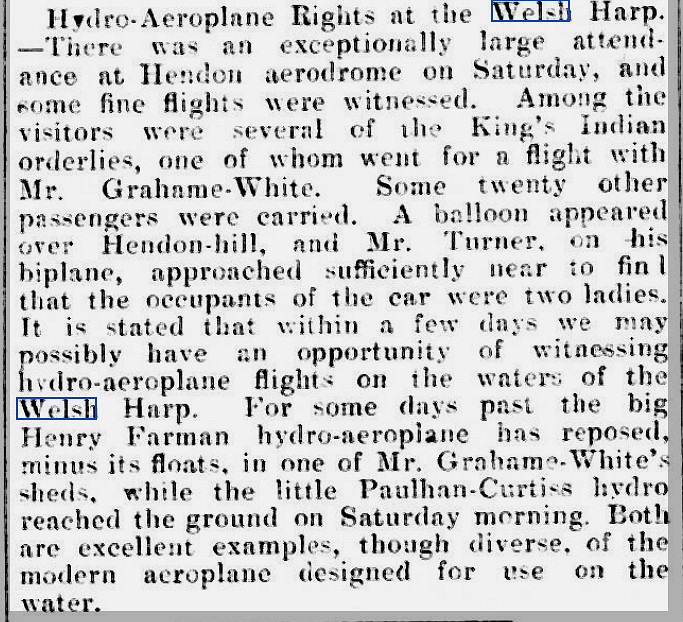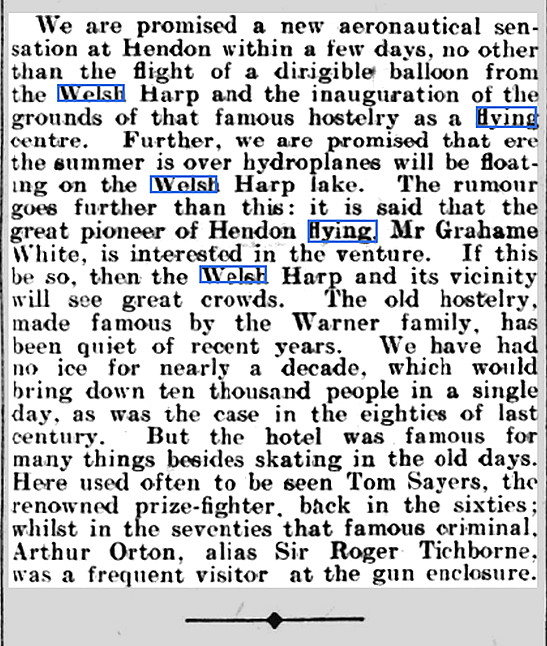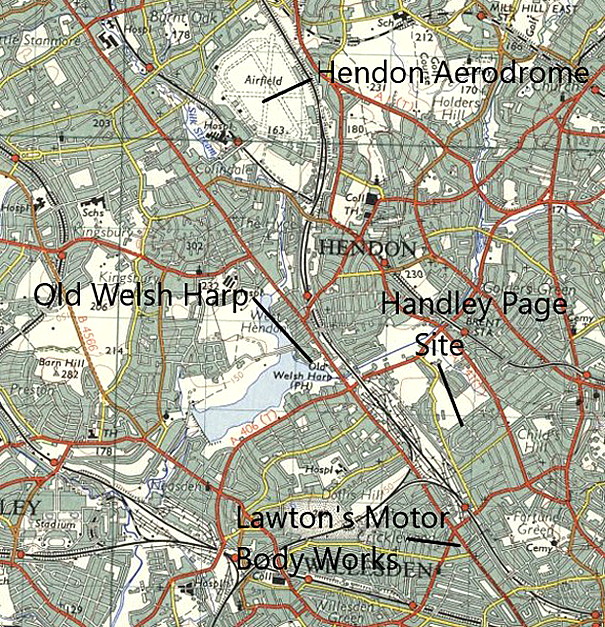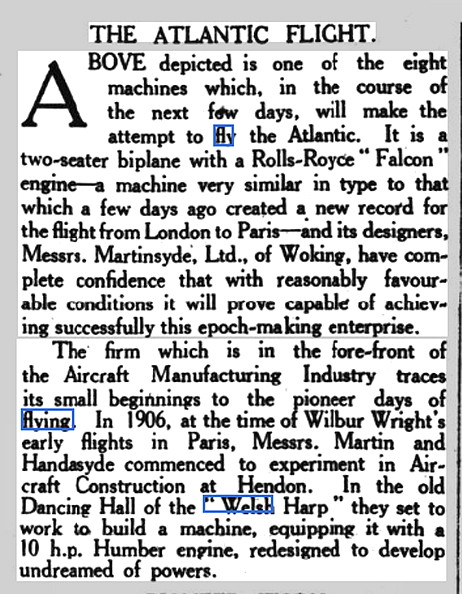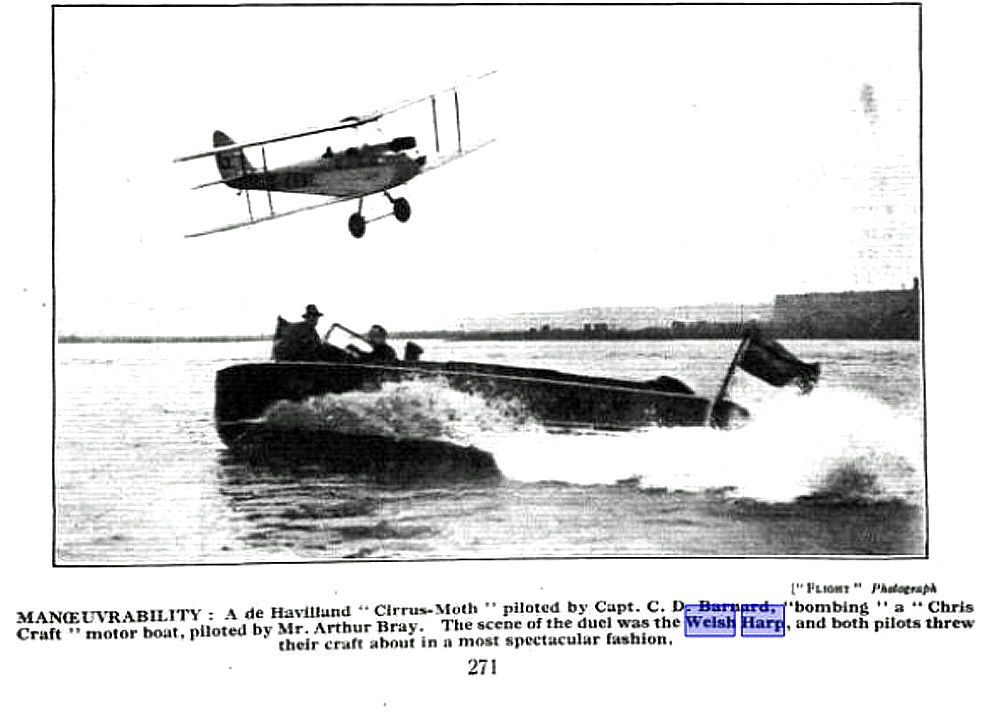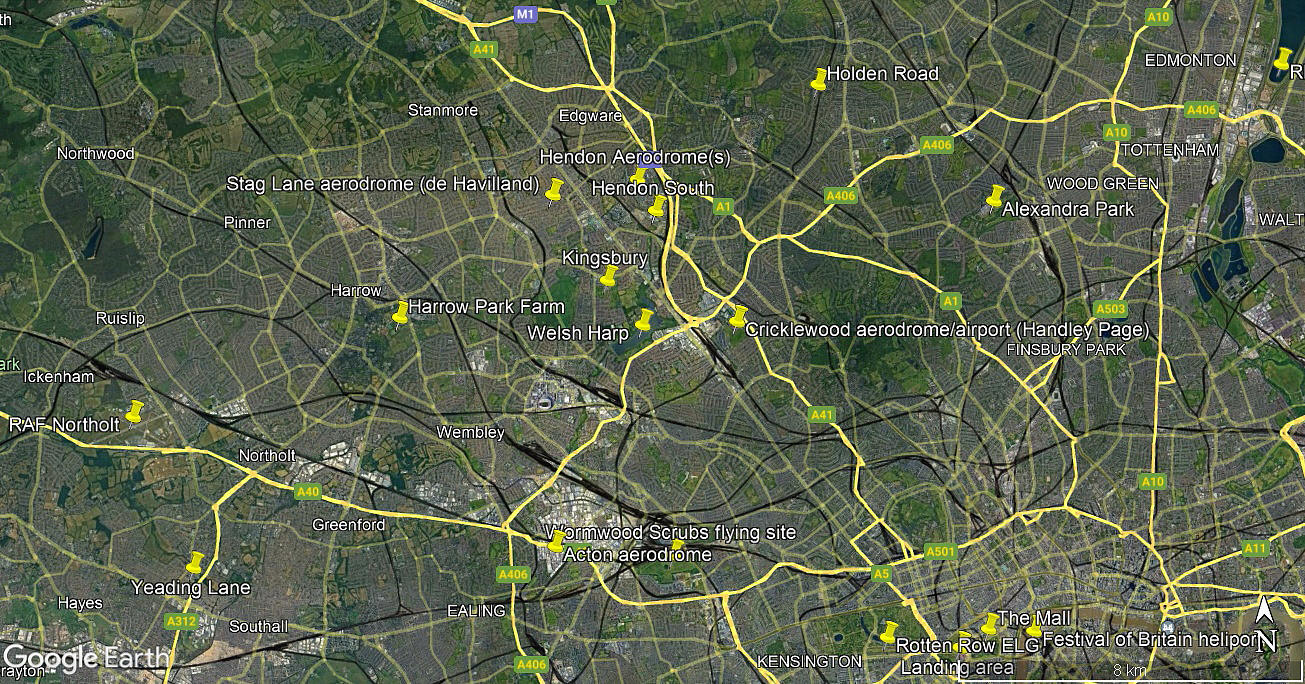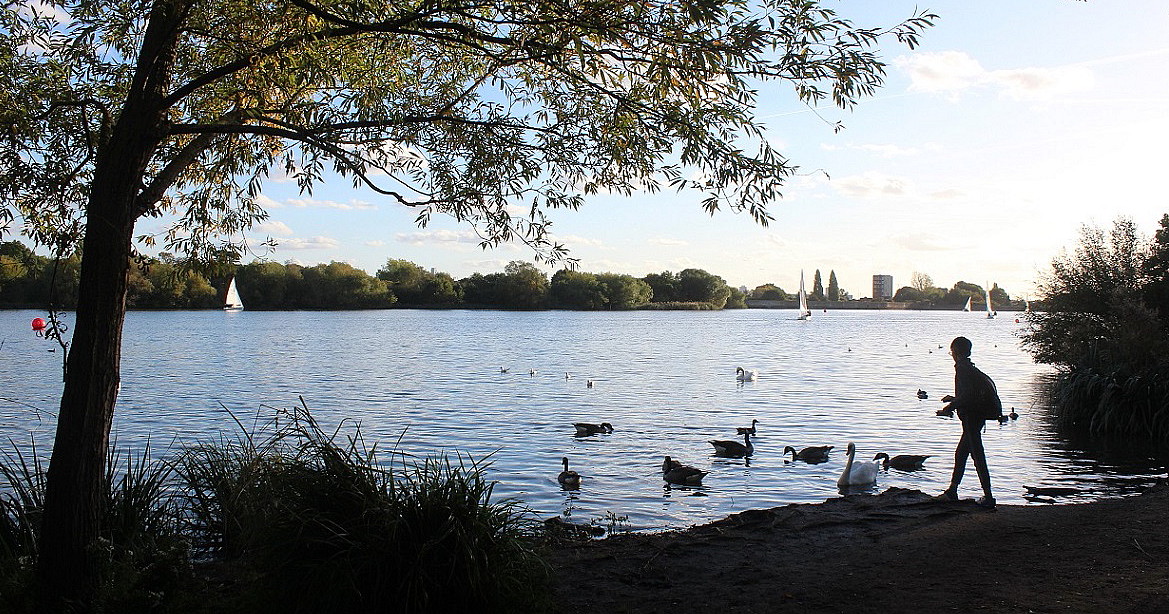Welsh Harp flying sites
Note: This map shows the position of the WELSH HARP / BRENT RESEVOIR.
WELSH HARP see also OLD WELSH HARP for a bit more information
WELSH HARP: Popular balloon launching site, also used by at least one of the early airships
Location: Just W of the Old Welsh Harp public house and venue, on the A5 just N of Staples Corner and at the eastern end of the Welsh Harp, (Aka BRENT RESEVOIR)
NOTES: It appears that when a gasworks was constructed in the mid 19th century (very roughly) to serve the lighting of railway stations on the line that passes through West Hendon, near to the Welsh Harp (now Brent Resevoir), several aeronauts used a site nearby to inflate their balloons and make ascents.
In his excellent book RAF Hendon Andrew Renwick states: “Most subsequent balloon flights were made from land near the Welsh Harp, with mixed results.” It appears the reason for this site becoming popular was the establishment of a gas works to provide lighting for the nearby railway stations. Percival Spencer made a number of successful flights, including the first flight of the balloon ‘Graphic’ on 14 May 1902. Before that, however, others had less success."
"In September 1880 a race was organised by the Balloon Society of Great Britain. Mr Adams was one of ten competitors and was supposed to start from the Welsh Harp. Unfortunately the balloon only reached an altitude of 100 feet and landed about half a mile from its starting point. In August 1892 Corsican Louis Henri Capazzi almost caused a riot. He was supposed to make a balloon ascent but the balloon slipped out of its net and took off without him. At this point the crowd turned angry and tried to attack him.” This was a common enough situation in those days and the aeronauts often decided to risk their lives ascending in dire conditions, rather than face ‘the mob’.
WELSH HARP: Temporary airship launching site
NOTES: The starting point for this listing was a photograph in Flying and Ballooning by John Fabb, captioned, “Armed with a megaphone and leaflets two suffragettes ascended in a balloon for the opening of Parliament, 1909.” The photograph portrays an airship but with only two people on board - one being the aeronaut (pilot) Henry Spencer of course
An internet search revealed an account of the flight told by Muriel Matters, (a sound recording), and saved in the BBC Archive. The airship had been hired by the Suffragettes from Henry Spencer and ‘Votes for Women’ had been applied across the airship envelope. The airship had been positioned near the WELSH HARP for Muriel to board and about a ‘hundredweight’ of leaflets were loaded. (She makes no mention of a megaphone being used).
They ascended to above 3000ft and Muriel started throwing out the leaflets. They were blown off course and didn’t over-fly the Houses of Parliament as intended. They landed, caught up in a tree, in Coulsden, Surrey. Nevertheless Muriel maintained the flight was a huge success, saying that just the sight of an airship brought people running for miles around.
A MICHAEL T HOLDER GALLERY
In around May 1922, Mike Holder who is a great friend of this 'Guide', decided to have a delve to see what information might be available regarding the WELSH HARP, and indeed THE OLD WELSH HARP. As you can see below there is quite a lot.
Note: The advert above is of interest in that when published in The Era on the 25th August 1900, George Spencer was already heavily engaged in using balloons for aerial advertising, and soon realised the potential of using airships. One of which he later built.
Note: This notice was published in the London Evening Standard on the 13th April 1901. The newspaper article was published in the Sheffield Evening Telegraph on the 17th December 1901.
Note: The newspaper article above was published in the Hendon Finchley Times on the 19th February 1909 and talks about the Suffragette movement hiring the Spencer dirigible airship. The map and last aerial photo shows the location of Lawton's Motor Body Works in Cricklewood, which is about a mile south of the Old Welsh Harp public House. This is where Cecil Compton Patterson had his second aircraft design built. He was originally based at FRESHFIELD on the coast in Lancashire, but realising the drawbacks of being based there moved to north London and became an instructor with Claude Grahame-White.
Presumably he had good enough reasons for not declaring his ambitions as an aircraft designer and builder, considering what was going on at HENDON where he was instructing, so remained somewhat secretive. It appears he tested his aeroplane from a field alongside the WELSH HARP, presumably on the south side? This was then open country, and the North Circular Road (A406), although started in 1910, was not opened until the early 1930s. And this was a new section not using existing roads. This said, try the North Circular in Ealing these days - do you call that finished!!!
Note: These two photos above were published in Flight magazine on the 26th July 1913, and show the Spencer airship signed up to advertise 'Bovril'. The first article was published in The Aeroplane on the 26th October 1911. The second article was published in the Hendon Finchley Times on the 26th July 1912. The excerpt was also published in The Aeroplane, but this time on the 17th April 1913.
Note: The article, in two parts above, was published in the Hendon Finchley Times on the 18th April 1913. The short article was published in Flight magazine on the 19th April 1913. I find it interesting that ballooning, for various purposes, was still popular right up until WW1. As the articles in this gallery clearly show. It would be roughly half a century later before ballooning resumed. Only this time of course, instead of using gas as the lifting agent, usually coal gas, it was back to the very beginnings in 1783 when the Montgolfier brothers used hot air. Modern technology of course has made this possible with compressed gas cylinders using advanced burner designs to produce the hot air. I still think that another major hot air resource is being ignored as there must be some way of harnessing the huge quantities being produced in parliaments and senates around the world.
Note: This two part article was published in the Evening Mail on the 17th April 1919.
AND FINALLY
Note: This article was published in Flight magazine on the 26th April 1913 and makes an interesting contrast with the picture alongside, also published in Flight magazine.
But, this time, on the 19th April 1928, almost exactly fifteen years later. I imagine the 'Chris Craft' speed boat had only recently been imported from the USA. Can't imagine this sort of thing being allowed today on the Welsh Harp - but hold on a mo. There is huge enthusiasm these days for celebrating centenaries, and as I write this in 2023 it is only five years to go before this centenary comes up. There are still a couple or more Cirrus Moths flying and I can easily imagine one of these classic 'Chris Craft' speedboats has been preserved? Just an acorn of an idea of course, but just look at what happens to some acorns.
The local area view is from my Google Earth © derived database.
WELSH HARP: Seaplane operating area.
Location: W of central Hendon, just N of the A406 North Circular Road
Period of operation: 1920s, 1930s and WW2 only?
NOTES: It seems that little is now known about the flying history of this site but it was certainly used by Colonel Semphill in 1928 using the Blackburn Bluebird G-EBSW. Was this aircraft based here perhaps? It also appears he then flew a DH80A Puss Moth on floats, (the only known example perhaps?), from here to Copenhagen in 1930?
But, Mr Graham Frost, a great friend of this 'Guide', has discovered another account. This reports that William Forbes-Semphill, aka Master of Semphill, set a new record on the 4th Semptember 1930 by flying the DH80A Puss Moth, G-AAVB, on floats, 1,040 miles from here to Stockholm. He then flew on up to Tallinn in Estonia on the 10th September, then onto Finland before returning via Norway to Aberdeen on the 22nd September.
So, I assume, the flight to Copenhagen was, in effect, a 'proving flight', to see what he could achieve?
WW2 HISTORY
It appears a seaplane, (presumably Fleet Air Arm?), was kept on standby here for a period during WW2. It was rumoured it was there to fly the Prime Minister, Winston Churchill, out of harms way if push came to shove with a German invasion. So presumably during the period when an invasion seemed imminent? This makes sense as the British Government had made plans to set up in exile in Canada if the invasion was succeeding. I imagine a seaplane was needed in order to rendezvous with a British warship to take the PM across the Atlantic?
As mentioned in more detail elsewhere in this 'Guide' the threat of an invasion was real enough at one point, but it soon became clear by RAF photo-reconnaissance flights that the invasion attempt was being abandoned. However, the threat was of enormous propaganda value and the 'myth' was kept going long after the actual threat had long since disappeared.
SOME VIEWS IN OCTOBER 2022
Note: The first, second and fourth pictures are of views looking south west. Only the third picture gives a partial view looking south east.
In October 2022, on a very fine clear day, I decided to see if I could get some pictures of 'The Welsh Harp' as it was once called. It took about two hours to find a path that offered some partial views, but there must be a location which offers a view along the entire reservoir? Most of the reservoir these days is bounded by dense vegetation and trees - hardly ideal for my purposes. Also, in more recent years since WW2 the reservoir has been very popular with dinghy sailing enthusiasts - perhaps not the case prior to WW2?
We'd love to hear from you, so please scroll down to leave a comment!
Leave a comment ...
Copyright (c) UK Airfield Guide




























